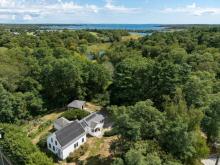Parks Board still has concerns with Round Hill salt marsh project
After an hours-long Parks Board meeting intended to answer members' concerns about a proposal to restore a salt marsh at Round Hill Beach, members remain worried about parking, safety, and how funding for the project could impact the beach.
The plan, which is supported by the Conservation Commission, Board of Health, and the state, would remove 72,000 cubic yards of sandy material to recreate the marsh, restore vegetation, and replace a now non-functioning culvert to provide necessary tidal flow. The marsh was filled in by the wealthy Ned Green in 1928 to create an airport.
The August 15 meeting drew a standing-room crowd, as board members met with town council Anthony Savastano, who detailed his review of the board’s concerns with the project. Among the top issues was the possibility that accepting funding from federal and state sources could open the beach up to non-residents – a key reason behind the board’s rejection of the proposal at a meeting on May 5. The Select Board got the project back on track in July.
“Right now, in the documents we reviewed, there is no requirement that the resident-only parking be abandoned,” Savastano said, noting that non-residents can currently access the beach legally by walking in from Smith Neck Road. Only parking is restricted to Dartmouth residents with proper beach stickers or passes.
Town Environmental Affairs Coordinator Michael O'Reilly, who has been working on the project since the mid-1990s, said it was his goal from the beginning to make sure the parking situation remains unchanged.
“I said from day one of the project that if there was ever any requirement that the Park Board’s policy regarding Dartmouth residents only parking would change – either through an upfront requirement of funding or at a later date as some sort of condition for the project – I would pull the plug,” O'Reilly said.
Parks Board member Joseph Vieira said after the meeting he still has worries about the future of the beach’s residents-only policy despite Savastano’s review of his concerns. Member James Vieira questioned if a non-resident could challenge the parking regulations in court.
Members also debated the idea of splitting up the property between the restored salt marsh area and the beachfront, and transferring ownership of the salt marsh portion to the Conservation Commission. That would mean no monies from the project would impact the beach portion at all, as the Parks Board would retain control of it.
But Parks Director Tim Lancaster said that option would also prevent allocating federal and state funds to cover improvements of beach facilities, like the septic and electrical systems.
In previous meetings, the board also raised safety concerns with a portion of the project that would add a culvert under Ray Peck Drive, particularly as it relates to young children. Lancaster said he still has issues with the safety and staffing requirements should the project go forward.
“I’ve been doing this long enough to know that the culvert, to a nine or 10-year-old boy or girl, is going to be like a jungle gym. There’s no doubt about it,” Lancaster said.
Lancaster said three additional staff members would need to be added to the beach to patrol the culvert area and keep kids out of it.
No vote was taken by the board to advance the project. Instead, at the request of Finance Committee member David Tatelbaum, the board voted to attend a joint meeting with the Select Board, Conservation Commission, and other boards and parties connected with the project.
The $5.1 million project would be funded by monies from the U.S. Fish & Wildlife Service, the U.S. Army Corps of Engineers, the Buzzards Bay Trustee Council, and the New Bedford Harbor Trustee Council.













